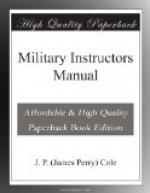Supports and parties bringing up bombs should only be moved up if the tactical situation demands it.
If troops in support or reserve lines of trenches remain in, or go into, dug-outs, they must continue to wear their anti-gas appliances.
Officers and N.C.O’s must on no account remove or open up the masks of the box respirators or raise their helmets to give orders. The breathing tube may be removed from the mouth when it is necessary to speak, but it must be replaced.
Men must always be on the look-out to help each other in case an anti-gas device is damaged by fire or accident. When a man is wounded, he must be watched to see that he does not remove his respirator or helmet until he is safely inside a protected shelter; if necessary, his hands should be tied.
Men must be warned that if they are slightly gassed before adjusting their respirators or helmets they must not remove them. The effect will wear off.
(2) TACTICAL MEASURES:
From the point of view of protection against gas, nothing is gained by men remaining in unprotected dug-outs or by moving to a flank or to the rear. It is, therefore, desirable that on tactical and disciplinary grounds all men in the front line of trenches should be forbidden to do these things. In support or reserve lines where there are protected dug-outs, it is advisable for men to stay in them unless the tactical situation makes it desirable for them to come out.
Nothing is gained by opening rapid rifle fire unless the enemy’s infantry attacks. A slow rate of fire from rifles and occasional short bursts of fire from machine guns will lessen the chance of their jamming from the action of the gas and tends to occupy and steady the infantry.
It should be remembered that the enemy’s infantry cannot attack while the gas discharge is in progress and is unlikely to do so for an appreciable time—at least 10 minutes—after it has ceased. It is, in fact, a common practice for the enemy infantry to retire to the second and third line of trench whilst gas is being discharged. There is, therefore, no object in opening an intense S.O.S. barrage of artillery on “No man’s land” during the actual gas cloud and it is advisable that the warning to the artillery of a gas attack should be a signal differing from the ordinary S.O.S. signal, as the latter may have to be sent later if an infantry attack develops.
It must be remembered that smoke may be used by the enemy at the same time as, or alternately with, the gas and that under cover of a smoke cloud he may send out assaulting or raiding parties. A careful look-out must, therefore, be kept; hostile patrols or raiders may be frustrated by cross-fire of rifles and machine guns and should an assault develop the ordinary S.O.S. procedure should be carried out.




